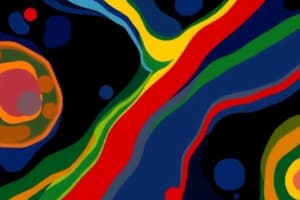Podcast
Questions and Answers
What is passive transport?
What is passive transport?
- Requires ATP or energy
- Goes from low to high concentration
- Goes from high to low concentration (correct)
- Moves large molecules
What is active transport?
What is active transport?
- Diffusion of water
- Does not require ATP or energy
- Movement of small molecules
- Goes from low to high concentration (correct)
What is facilitated diffusion?
What is facilitated diffusion?
- Requires ATP
- Movement of small molecules
- Movement of water
- Movement of larger molecules through carrier proteins (correct)
What is diffusion?
What is diffusion?
What is osmosis?
What is osmosis?
Does diffusion require energy?
Does diffusion require energy?
Does osmosis require energy?
Does osmosis require energy?
Does facilitated diffusion require energy?
Does facilitated diffusion require energy?
Does active transport require energy?
Does active transport require energy?
Does exocytosis require energy?
Does exocytosis require energy?
Does endocytosis require energy?
Does endocytosis require energy?
Which direction does diffusion go?
Which direction does diffusion go?
Which direction does osmosis go?
Which direction does osmosis go?
Which direction does active transport go?
Which direction does active transport go?
Does diffusion require a protein channel?
Does diffusion require a protein channel?
Does facilitated diffusion require a protein channel?
Does facilitated diffusion require a protein channel?
What is an example of facilitated diffusion?
What is an example of facilitated diffusion?
What is an example of osmosis?
What is an example of osmosis?
What is an example of diffusion?
What is an example of diffusion?
Flashcards are hidden until you start studying
Study Notes
Transport Mechanisms
- Passive Transport: Moves substances from high to low concentration without ATP or energy.
- Active Transport: Moves substances from low to high concentration, requiring ATP or energy.
Types of Passive Transport
- Facilitated Diffusion: Larger molecules (like salts, starches, and sugars) cross through carrier proteins.
- Diffusion: Small molecules such as gases (Oxygen and Carbon Dioxide) move directly through membranes.
- Osmosis: Specific type of diffusion, referring exclusively to the movement of water across cell membranes.
Types of Active Transport
- Sodium-Potassium Pump: A carrier protein mechanism that moves sodium out and potassium into the cell against their concentration gradients.
- Endocytosis: Engulfing of large particles into the cell; often described as "cell eating".
- Exocytosis: Expelling of large particles from the cell; often termed as "cell puking".
Energy Requirements
- Passive transport methods (Diffusion, Osmosis, Facilitated Diffusion) do not require energy.
- Active transport methods (Active Transport, Endocytosis, Exocytosis) require energy.
Concentration Gradients
- Diffusion, Osmosis, Facilitated Diffusion: All move substances toward lower concentrations.
- Active Transport: Moves substances toward higher concentrations.
- Endocytosis: Directly related to movement into the cell.
- Exocytosis: Involves movement toward the outside of the cell.
Protein Channel Dependency
- Facilitated Diffusion and Active Transport: Both require a protein channel to assist in the transport of substances.
- Diffusion, Osmosis, Endocytosis, and Exocytosis: Do not rely on protein channels for transport.
Examples of Transport Mechanisms
- Facilitated Diffusion Examples: Movement of salts, starches, and sugars.
- Diffusion Examples: Carbon Dioxide and Oxygen exchange in lungs.
- Osmosis Example: Water movement through cell membranes.
- Active Transport Example: Use of protein pumps.
- Endocytosis Example: White blood cells ingesting bacteria.
- Exocytosis Example: Removal of waste and release of hormones.
Studying That Suits You
Use AI to generate personalized quizzes and flashcards to suit your learning preferences.





